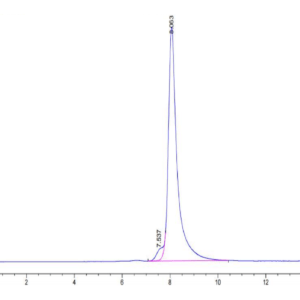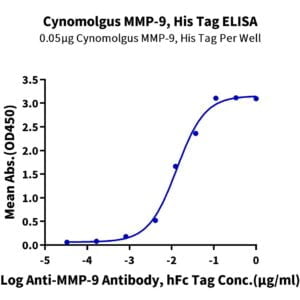| Weight | 1 lbs |
|---|---|
| Dimensions | 9 × 5 × 2 in |
| accession | Q16790 |
| express system | HEK293 |
| product tag | C-His-Avi |
| purity | > 95% as determined by Tris-Bis PAGE;> 95% as determined by HPLC |
| background | CA9 is a member of the carbonic anhydrases' family, that is often expressed in cancer cells under hypoxic condition. CA9 expression potentially contributes to the regulation of cancer cell differentiation and mediates tumour-associated genes and signalling pathways, including apoptosis, hypoxia, G2M checkpoint, PI3K/AKR/mTOR signalling and TGF-beta signalling pathways. |
| molecular weight | The protein has a predicted MW of 43.7 kDa. Due to glycosylation, the protein migrates to 50-60 kDa based on Tris-Bis PAGE result. |
| available size | 100 µg, 500 µg |
| endotoxin | Less than 1EU per μg by the LAL method. |
Human CA9/Carbonic Anhydrase IX Protein 4635
$330.00 – $1,100.00
Summary
- Expression: HEK293
- Active: Yes (catalytic)
- Amino Acid Range: Gln38-Asp414
Human CA9/Carbonic Anhydrase IX Protein 4635
| protein |
|---|
| Size and concentration 100, 500µg and lyophilized |
| Form Lyophilized |
| Storage Instructions Valid for 12 months from date of receipt when stored at -80°C. Recommend to aliquot the protein into smaller quantities for optimal storage. Please minimize freeze-thaw cycles. |
| Storage buffer Shipped at ambient temperature. |
| Purity > 95% as determined by Tris-Bis PAGE |
| target relevance |
|---|
| CA9 is a member of the carbonic anhydrases' family, that is often expressed in cancer cells under hypoxic condition. CA9 expression potentially contributes to the regulation of cancer cell differentiation and mediates tumour-associated genes and signalling pathways, including apoptosis, hypoxia, G2M checkpoint, PI3K/AKR/mTOR signalling and TGF-beta signalling pathways. |
| Protein names Carbonic anhydrase 9 (EC 4.2.1.1) (Carbonate dehydratase IX) (Carbonic anhydrase IX) (CA-IX) (CAIX) (Membrane antigen MN) (P54/58N) (Renal cell carcinoma-associated antigen G250) (RCC-associated antigen G250) (pMW1) |
| Gene names CA9,CA9 G250 MN |
| Protein family Alpha-carbonic anhydrase family |
| Mass 9606Da |
| Function Catalyzes the interconversion between carbon dioxide and water and the dissociated ions of carbonic acid (i.e. bicarbonate and hydrogen ions). |
| Catalytic activity BINDING 226; /ligand="Zn(2+)"; /ligand_id="ChEBI:CHEBI:29105"; /ligand_note="catalytic"; /evidence="ECO:0000269|PubMed:19805286"; BINDING 228; /ligand="Zn(2+)"; /ligand_id="ChEBI:CHEBI:29105"; /ligand_note="catalytic"; /evidence="ECO:0000269|PubMed:19805286"; BINDING 251; /ligand="Zn(2+)"; /ligand_id="ChEBI:CHEBI:29105"; /ligand_note="catalytic"; /evidence="ECO:0000269|PubMed:19805286"; BINDING 332..333; /ligand="substrate"; /evidence="ECO:0000250|UniProtKB:P00918" |
| Subellular location Nucleus. Nucleus, nucleolus. Cell membrane ; Single-pass type I membrane protein. Cell projection, microvillus membrane ; Single-pass type I membrane protein. Note=Found on the surface microvilli and in the nucleus, particularly in nucleolus. |
| Tissues Expressed primarily in carcinoma cells lines. Expression is restricted to very few normal tissues and the most abundant expression is found in the epithelial cells of gastric mucosa. |
| Structure Forms oligomers linked by disulfide bonds. |
| Post-translational modification Asn-346 bears high-mannose type glycan structures. |
| Target Relevance information above includes information from UniProt accession: Q16790 |
| The UniProt Consortium |















